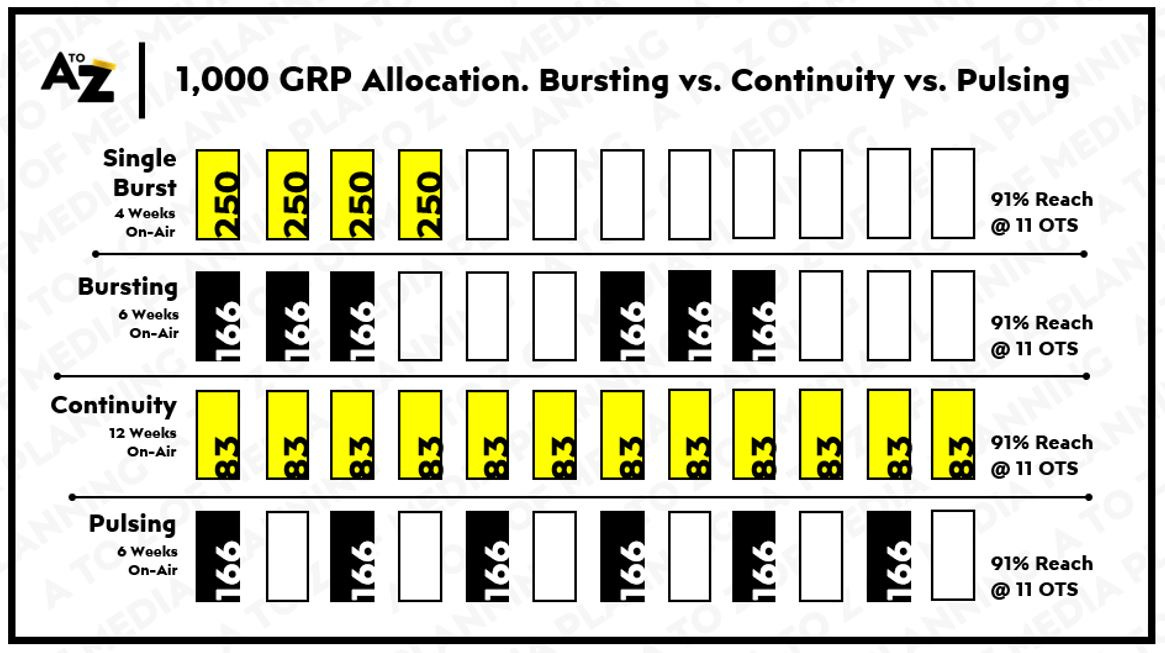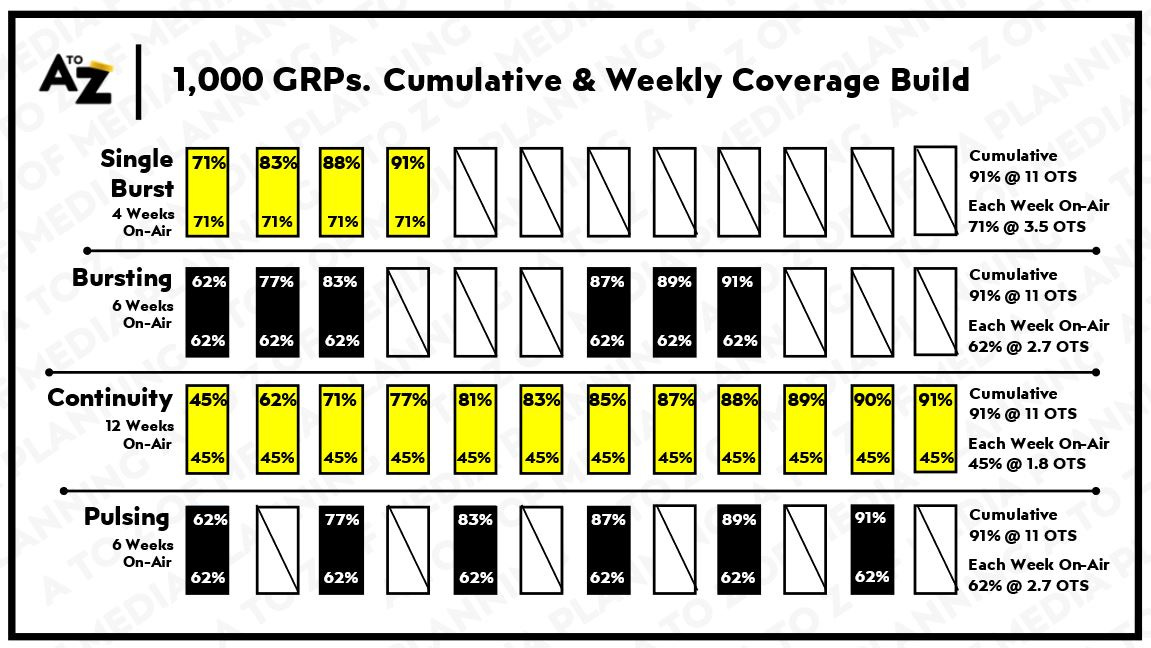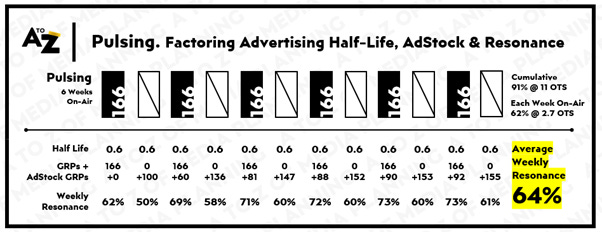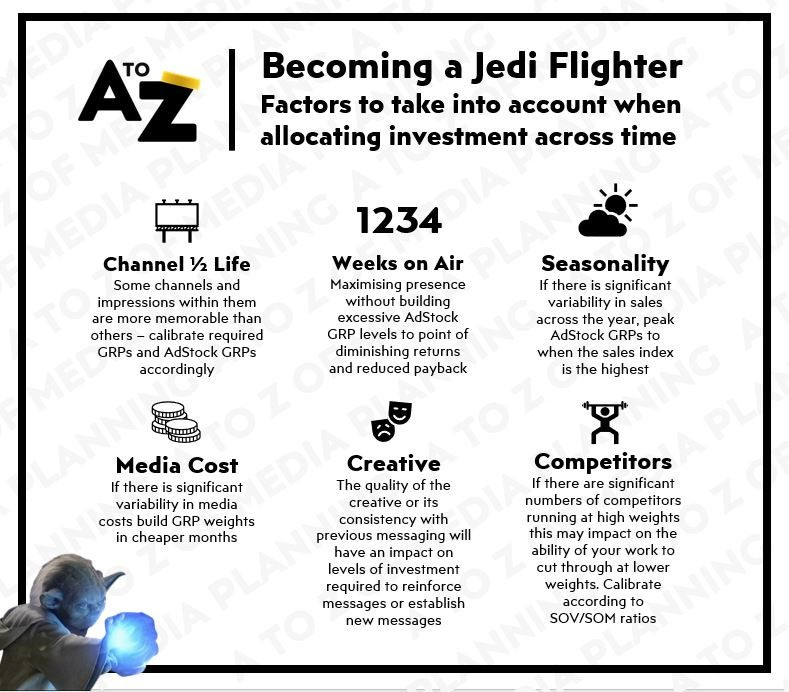F is for... Frequency
Become a jedi-flighter by managing frequency of ad exposure across time
When sharing the previous chapter on Effectiveness I asked readers what might be a good topic to cover for F.
One said Feelings, quite a few people said Fame but the vast majority of people responded saying Frequency was something they wish they had a better grasp of as a planner, when getting to grips with the nuts and bolts of media planning.
Whilst Frequency and the associated discipline of Frequency Management might not deliver exponential gains for those that have a mastery of it…those that make bad choices in this area can place a cap on a campaign’s potential to deliver the best outcomes.
Hence F… is for Frequency
Where I touch on some of the research that has taken place in this area, before walking through a practical example of how the choices we make when managing frequency may impact our resulting resonance in consumers minds.
Let’s start with some theory.
Broadly speaking the more people a brand can reach, more often than its competitors throughout people’s lives, the more likely that brand will come to mind in buying situations.
No shock there.
If reach is the number of unique individuals your campaign will…reach… then frequency is the average number of times that campaign will be experienced by each unique individual.
A simple calculation that divides the total number of ad impressions, by the number of people your campaign will be estimated to reach.
It can be calculated within channels, it can be estimated across channels.
A super simple construct.
However these estimations, are just that. Estimations.
There is a reason why on a media plan itself frequency is labelled as OTS or Opportunity to See.
As each plan that is constructed and implemented merely gives a campaign or activation the opportunity to be seen… by no means a guarantee that it will be given full attention, understood and encoded in people’s minds as intended… or recalled and subsequently acted upon later down the line when someone comes to market.
At least not with one exposure to it when people are scrolling their phones or walking to work.
To make it trickier not all exposures are equal either.
Some ads are more memorable than others from a creative perspective.
Some formats are more impactful than others from a media perspective.
Some channels can reach more people, faster than others from a sheer volume perspective.
Which is why over the years there has been much debate and deliberation over how much frequency is required for an ad campaign to be effective and how that frequency should be managed at a moment in time for one campaign, or across multiple campaigns for a longer period of time.
Hence the disciple of Frequency Management.
Before I give some suggestions on how I go about managing frequency to give a campaign the best chance of delivering the largest payback, it makes sense to give you some background on how our understanding of frequency has evolved to date.
Three… was the magic number
An American named Herb Krugman published a research paper “Why Three Exposures Might Be Enough” 50 years ago which aimed to answer how many exposures to advertising were enough to create a desired response.
He argued from a psychological perspective, there are three exposures the mind responds and reacts to when processing advertising and communications.
1. The First exposure: ‘What is this?’
2. The Second exposure: ‘What does it mean?’
3. Subsequent exposures: “Oh it’s that ad again”
This wasn’t supposed to be a literal recommendation on ad-exposures to optimise to, Krugman talked about multiple ad exposures being required to move between each of these psychological states.
As we all know however, communications is what is received and perceived not what is intended.
Subsequently Krugman’s paper in combination with empirical reviews of effective frequency that followed later in the 70s led to some widely adopted rules of thumb amongst media departments across adland… that optimising a plan to maximise 3+ reach in a given purchase cycle, would create the maximum impact.
This resulted in media plans shaped with intensive bursts of advertising to get the most possible people seeing the 3 times or more, before the dollars inevitably ran out and were followed with fallow periods of relative silence.
Optimising to Frequency Recency
This approach was commonplace for another 20 years until Recency planning was introduced by media practitioner, turned scholar, Erwin Ephron in the 90s as a potentially better way of planning advertising activity across time.
With it he introduced two concepts that challenged conventional wisdom on advertising frequency up to that point.
1. Recency planning placed more emphasis on “purchases” as opposed to “purchasers”
As most categories are continuously bought throughout the year, being the last ad people see before they get their wallet out to remind them you’re an option, may be wiser than trying to “teach” purchasers the merits of your products through forced repetition of message.
2. Recency planning placed more emphasis on “reach” rather than “frequency”
As the first impression in a given week or purchase cycle creates the largest response.
This shift in emphasis enabled brands to afford longer periods of activity on-air and be present across more buying occasions relative to the preceding 3+ method.
This school of thought was then supported, then popularised further with the publication of How Brands Grow where Byron Sharp further evidenced Reach being more important than Frequency and Continuity being more effective than Bursts.
From theory to practice
So just split your budget by 52 and off you go then?
There are worse choices you might make… but unfortunately, it’s not quite as simple as that.
Each category has a different dynamic, with different levels of competitiveness.
Each brand within each category requires different outtakes and outcomes from exposure to its range of marketing communications in order to change attitudes, to reinforce them, to raise awareness of a new product or service or simply drive action.
Each channel and each advertising format available within each channel offer variations of size, scale, length, depth and likely attention and resulting depth of impression in people’s minds.
To reconcile this, good media planners don’t just pay attention to where they are allocating their investment across channels, they also pay attention to how that investment is allocated across time.
Also known as the discipline of Flighting.
Which is the management of advertising exposure and frequency across time.
Illustrated by Example
To help you get to grips with some flighting tips and tricks I’m going to walk through a fictitious ask, from a fictitious marketing manager, representing a fictitious FMCG brand.
To keep it simple this is a brand and product many are familiar with, that has just been allocated a media spend for the upcoming quarter.
It can afford roughly 1,000 GRPs across that period of 12 weeks, a healthy weight!
But the marketing manager has asked for some scenarios to show their superiors how they might best flight that activity across the upcoming quarter to maximise sales.
Now there are infinite ways you might choose to do this, but flighting approaches tend to be variations of 3 approaches…Bursting, Continuity or Pulsing.
As represented by the graphic below which has allocated those GRPs according to each flighting strategy.
At face value, the implications of each approach aren’t all that dissimilar as the total delivery of the campaign is the same.
A healthy 91% of the population 11 times across the quarter.
The Single Burst over 4 weeks delivers that reach and frequency faster.
The Continuity approach delivers it more steadily over time and affords more “weeks on-air” as a consequence.
Erwin would be proud.
Whereas the Bursting & Pulsing scenarios I’ve built out fall somewhere in-between.
The only real differences between the 4 scenarios being the numbers of weeks on air and the average reach and frequency of those respective weeks on air – all of which directly correlates to how those GRPs have been allocated.
As you’ll notice the Single Burst would be unavoidable, but expensive and potentially excessive.
Bursting & Pulsing aren’t too dissimilar as they deliver the same volume of GRPs across the same number of weeks on air.
The Continuity approach delivers less weight per week, but has the most weeks on-air.
So let’s introduce the differentiator.
Advertising Half-Life & AdStock GRPs.
When someone experiences an ad it doesn’t just work in that moment then is wiped from our memory, Tommy Lee Jones in Men in Black style… it can be recalled and potentially acted upon days, weeks, months or even years after it was experienced.
We’ve all got ads that we’re constantly reminded of in our everyday lives.
Walking past the soft-drinks aisle in a supermarket still triggers this ad made in the 70s that was still running when I was a child of the 80s.
But these types of advertising impressions are very much the exception, rather than the norm.
For most of the thousands of commercial messages we experience each day, that impression in our minds generally weakens over time, most of them pretty instantly, creating what is termed a Half-Life that can quantify how advertising continues to effect consumer behaviour from one week, month or year to the next.
The prolonged or lagged effect of advertising on consumer behaviour is termed AdStock that can be converted into equivalent GRPs that carry over from one week to the next.
This half-life is a key component of econometric modelling techniques that help to pull apart the true attribution of advertising impact to the channels that created it.
Depending on your channel mix, I’ve seen econometric models carry over as much as 80% (where TV as a high attention, high impact medium is the lead channel) of that advertising half-life from one week to the next and as little as 10% in others (Where a low-attention medium such as Digital Display or Paid Social might be the lead channel).
This means if for instance if you ran 100 GRPs one week with a Half-Life factor of 50% - this weight of impression that carries over from that week to the next is the mathematical equivalent of buying another 50 GRPs the following week.
These “half-lives” enable planners with the appetite and evidence to use them, forecast how a campaign can build resonance in consumers minds over time and how it will eventually fall to ZERO once the advertising stops.
Because much like a leaky bucket, we need to ensure those levels of resonance don’t fall to a level that might leave you at risk of, in the words of Erwin, your competitors eating your lunch.
When you factor AdStock GRPs and its resulting Resonance in people’s minds, the implications of the different flighting patterns for our fictitious client tell a very different story.
Taking the single burst, whilst that cumulative reach and frequency is built quickly, the silence soon kicks in with weekly resonance falling off a metaphorical cliff for the last 6 weeks of the quarter.
Averaging out at 55% for the quarter but will soon need replenishing at scale.
By simply moving from one super high intensity burst like above which is how media was planned in the 70s & 80s, to two moderate intensity bursts (as indicated below) significantly improves the resulting Average Weekly Resonance figure across the quarter from 55% to 62% - and in doing so never letting those AdStock GRPs fall below a weight that may risk us not being top of mind.
Whilst this method represents a step-change, there is still room for further improvement in those resonance measures through flighting adjustments alone.
By adopting either a continuity approach or a pulsing approach, those weekly resonance figures can be nudged up further still to 63% or 64% respectively as indicated by the graphics below.
Whilst moving from 62% to potentially 64% might not sound like a big deal, if the target audience was all individuals in the U.K. this would result in you effectively connecting with over 1,000,000 more individuals, every week during that quarter for exactly the same investment.
This is why it’s so important to manage frequency of exposure across time.
It doesn’t just work in spreadsheets, it works in real-life too.
Research from Nielsen showed “weeks on air” as being one of the three biggest levers for increasing advertising payback, with differences in the 10s of % points.
Something the leaders of many a marcomms led organisation know only too well.
Procter & Gamble’s Marc Pritchard is one of several brand leaders to have spoken against the perils of “excess frequency” and the perception that media dollars are being spent on serving ads to consumers who no longer require the exposure or – worse – are actively irritated by the repetition.
Now you know the basics, how do you become a jedi-flighter?
Once you understand the basics, you can then take your flighting game up a level by factoring in other variables such as the competitiveness of the category, the seasonality of purchase, the seasonality of media cost, the attentiveness of channels and the quality of the creative to build the most robust recommendations for your clients on how they might flight their media and what the implications for production might be.
This is by no means exhaustive, but are my go to optimisations.
You can also take this more sophisticated approach born in FMCG to other types of campaigns and categories to show you have a real grasp of the fundamentals, which I often find acts as license to spend more time talking about the more fun elements of the plan – i.e. creative uses of media.
Some key takeaways
I hope you’ve found this section of use and at just over 2,500 words a little more digestible than some of the previous chapters.
What I wanted you to take-out of this chapter is as follows…
Good Flighting may not exponentially increase the effectiveness of a campaign in the same way a great creative might, but Bad Flighting can do real damage to the potential payback of a campaign as I’ve shown with the different flighting scenarios.
Whereas there are infinite adjustments a media planner might make on how to flight media, they fall into 3 broader approaches.
Bursting condenses activity into short periods of high reaching, high intensity media.
Whilst payback may fall short of the other approaches on a macro-level, bursts are great ways of bringing new-news to market in ways that can help a brand, product or service be put on the metaphorical map.
Just be sure to follow it up with media that can continue that momentum at lower weights.
Bursts are the de-facto flighting pattern for entertainment releases as well.
Pulsing & Continuity stretches activity across time to cover more buying occasions and has been proven to increase the payback of a campaign as a consequence.
Pulsing lends itself to established categories, with established messaging, that simply needs topping up in people’s minds over time in the most efficient way.
FMCG would be a great example of categories that pulse their way to Salience.
Continuity lends itself to highly competitive categories, that are frequently used, with clients that can afford to be on air each week at weights that can cut-through.
The burgeoning/bubbling world of VC-funded delivery services would be a good example of this.
One watch-out is that there is no universal Half-Life and resulting AdStock.
Work with your in-house Data, Measurement & Analytics teams or get in contact with independent specialists such as Magic Numbers to help you model these out in a statistically significant way.
I hope you’ve found something of use, if you think I’ve missed something (or even worse misrepresented something) please feel free to email me at matt.prentis@gmail.com and I’ll append it to the post.
Any suggestions for G are more than welcome too!
Until next time : )













this was a really helpful post on Frequency! as a digital media planner, I feel alot of my peers don't have the same media basics foundation as a traditional media planner & this post is great learning for such people.
With all the Attention studies coming out from Lumen etc., channel & ad format will definitely have an impact on Half Life. as an example, social platforms would rank low on attention but equally the various of ad formats such as Static-Feed vs. Story vs. Reel would also have their own weights.
Great blog , and love some proper media geekery! A key point in the flighting debate though is that without long and short reach goals you end up reaching the same “easy to reach” segment each reporting period. 40% over 3 periods might be 40% 1+, or it might be 70%. It’s ideal to get planners trained not to quote frequency without also describing the period it covers